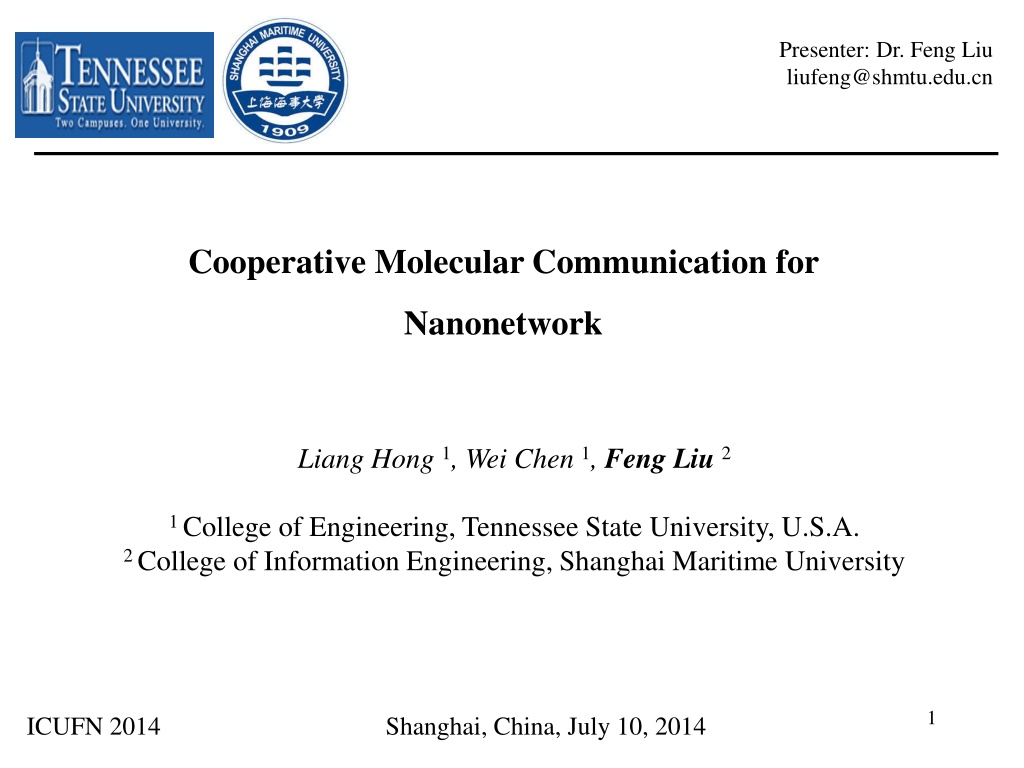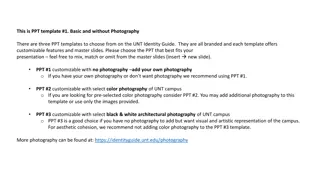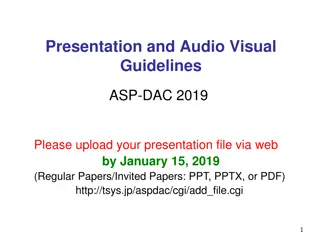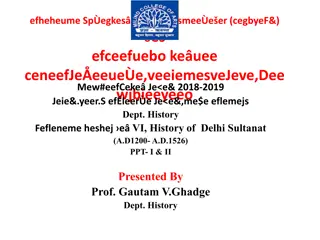
Cooperative Molecular Communication for Nanonetwork
Explore the world of nanotechnology with molecular communication, enabling nanomachines to communicate and collaborate for various applications. Dr. Feng Liu presents a research goal to enhance communication reliability in nanonetworks while maintaining low system complexity. Discover the potential of nanotechnology in shaping future networks and devices at nanometer scales.
Download Presentation

Please find below an Image/Link to download the presentation.
The content on the website is provided AS IS for your information and personal use only. It may not be sold, licensed, or shared on other websites without obtaining consent from the author. Download presentation by click this link. If you encounter any issues during the download, it is possible that the publisher has removed the file from their server.
E N D
Presentation Transcript
Presenter: Dr. Feng Liu liufeng@shmtu.edu.cn Cooperative Molecular Communication for Nanonetwork Liang Hong 1, Wei Chen 1, Feng Liu 2 1 College of Engineering, Tennessee State University, U.S.A. 2 College of Information Engineering, Shanghai Maritime University 1 ICUFN 2014 Shanghai, China, July 10, 2014
Presenter: Dr. Feng Liu liufeng@shmtu.edu.cn Cooperative molecular communication for nanonetwork Outline Introduction Problem Statement and Research Goal Cooperative Communication System Model Proposed Decode-and-Forward Relay Scheme Simulation Results Conclusions 2
Presenter: Dr. Feng Liu liufeng@shmtu.edu.cn Cooperative molecular communication for nanonetwork Introduction (1) Nanotechnology is enabling the development of devices in a scale ranging from one to a few hundred nanometers. At nanometer scale, a nanomachine is the most basic functional unit to perform simple tasks, such as computing, data storing, sensing or actuation. Communication among nanomachines will expand the capabilities and applications of individual nanomachines in terms of both complexity and range of operation. 3
Presenter: Dr. Feng Liu liufeng@shmtu.edu.cn Cooperative molecular communication for nanonetwork Introduction (2) Molecular communication (MC) is the most promising method for nanoscale communication. In molecular communication, information is transmitted over an aqueous medium by molecules. The information can be encoded in release time, concentration or type of molecules. Nanonetwork, a future network paradigm, is formed with the interconnection of nanomachines. Numerous applications of nanonetworks have been proposed in the biomedical, environmental, military, and industrial fields. 4
Presenter: Dr. Feng Liu liufeng@shmtu.edu.cn Cooperative molecular communication for nanonetwork Problem Statement Most existing research works only focus on single transmitter and single receiver system. The reliability of communication degrades rapidly when the distance between transmitter and receiver increases. A few research works using multiple-input multiple-output technique, multi-hop communication, and collaborative relay have been reported. However, they are not practical because these methods require either perfect coordination or grouping that will significantly increase system complexity. 5
Presenter: Dr. Feng Liu liufeng@shmtu.edu.cn Cooperative molecular communication for nanonetwork Research Goal Propose and evaluate a cooperative molecular communication solution that can improve system communication reliability with low system complexity and is easy to implement. 6
Presenter: Dr. Feng Liu liufeng@shmtu.edu.cn Cooperative molecular communication for nanonetwork Cooperative Communication System Model Single-hop Molecular Communications Unguided Diffusion Communication Corresponding to conventional wireless communication Guided Diffusion Communication Corresponding to conventional wired communication Information Molecule format Sender address + information + receiver address = 7
Presenter: Dr. Feng Liu liufeng@shmtu.edu.cn Cooperative molecular communication for nanonetwork Impact of Transmitter-Receiver Distance Impact of transmitter-receiver distance on the number of received information molecules (without using relay molecular) N3Sim: a simulation framework for the general case of diffusion-based molecular communication 8
Presenter: Dr. Feng Liu liufeng@shmtu.edu.cn Cooperative molecular communication for nanonetwork Proposed Decode-and-Forward Relay Scheme Cooperative Molecular Communication at Physical Layer Similar to any other communication system, modulation is an indispensable process in the transmitter. The demodulation is the corresponding reverse process to the modulation process in the receiver Concentration shift keying (CSK), where different concentrations of signaling molecules are used by the transmitter to represent different transmission symbols. is used at physical layer in this research due to less inter-symbol interference, less average amount of released molecules per message, and less complexity of transmitter and receiver nano-machine. 9
Cooperative Molecular Communication at Link Layer and Network Layer Information representation: double complement DNA strands bound together by Watson-Crick Complementarity Nano Network Modeling: n nano-machines/nodes each node has an address represented by a double strand DNA molecule. nodes a and b have a link if a can diffuse the molecular information to b and vice versa. 10
Molecular Operations: 1. Cutting cut a double stranded DNA sequences \into two single (partially single) DNA sequences by some special enzyme. 2. Linking/binding Two partially singled and complementary DNA sequences can be linked together by some special enzyme. 11
Molecular address and routing table: Suppose there are kdestinations, D1, D2, , Dk, in the network, and node i can relay the information via its neighbors j1, j2, , jk, respectively. The routing table at node i has k items as follows: 12
Build the routing table for each node Step 1: For each node i, prepare n addresses for each pair of node i and node j (1 j n). Step 2: Broadcast/diffuse addresses pairs of i and j for all j. Step 3: For each node i, when i receives an address sequence, it will link with it to form a longer address sequence. Repeat Step 3 enough times so that i can receive the address from any reachable node in the network. Step 4: Discard any address sequence longer than n. Repeat the following Steps until no address list left: Step 5-A: Select the shortest address sequence L. Suppose that it is formed by the addresses of i, j1, j2, , jk. Step 5-B1: Cut address i and its neighbor j1 from L and make enough copies of them. Then cut j2, make double copies of j2. If j2 has not been the destination yet, make a routing item for destination j2 by binding operation. Step 5-B2: If j3 has not been destination yet, make a routing item for j3. Step 5-Bk: If jk has not been destination yet, make a routing item for jk. 13
Data relay protocol Node i relays a piece of information to destination d via nodes n1, n2, , nk. 1. Node i binds the information with a routing item. 2. Node i broadcasts/diffuses the information with the routing item. When the information arrives at i s neighbors, the routing item will be attached by n2 s address. It implies that in next step only node n1 continue the relay and transmits the information to destination d via neighbor n2. 3. Step 2 will be repeated by n1, n2, , nk. Finally, the information is relayed to destination d. 14
Cooperative data relay protocol In the cooperative data relay protocol, multiple nodes i1, i2, , ik will collaborate to relay information via same node j. In this case, the routing tables of nodes i1, i2, , ik, have the same relaying item for node j. With cooperative data transmission, the number of received information molecules could be increased to k times through the diversity gain. Therefore the system s noise resistance performance can be improved. 15
Presenter: Dr. Feng Liu liufeng@shmtu.edu.cn Cooperative molecular communication for nanonetwork Simulation Settings Signal propagation model ? ? = ? ? + ??? + ??? ? ? : mean received number of molecules ??? : Brownian noise due to molecules random thermal motion ??? : residual noise due to the received molecules from previously transmitted symbols Coefficients for the residual noise were obtained using curve-fitting on the N3Sim results Distance between the transmitter and receiver is 2000nm. Relays are located evenly between the transmitter and receiver. 16
Presenter: Dr. Feng Liu liufeng@shmtu.edu.cn Cooperative molecular communication for nanonetwork Simulation Results System performance improvement with cooperative technique (repeating): 17
Presenter: Dr. Feng Liu liufeng@shmtu.edu.cn Cooperative molecular communication for nanonetwork Conclusions Propose and evaluate a novel cooperative molecular communication solution to improve system communication reliability. Signals are repeated by the nanomachines located between the transmitter and receiver. There is no need of grouping and coordination. Therefore, the system has low complexity and is easy to implement. Simulation results show that the bit error rate is much lower than that of the non-cooperative scheme. 18
Presenter: Dr. Feng Liu liufeng@shmtu.edu.cn Cooperative molecular communication for nanonetwork Acknowledgement This work was partially supported by the National Natural Science Foundation of China (61271283), the Innovation Program of Shanghai Municipal Education Commission (15YZ113), and the Science & Technology Program of Shanghai Maritime University (20120107). 19
Presenter: Dr. Feng Liu liufeng@shmtu.edu.cn Cooperative molecular communication for nanonetwork Thank you! Questions? 20





















